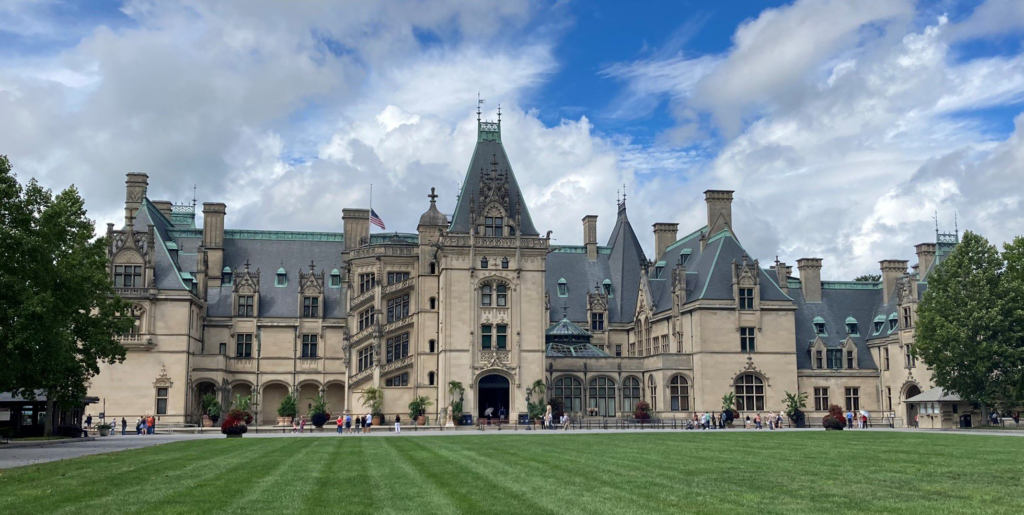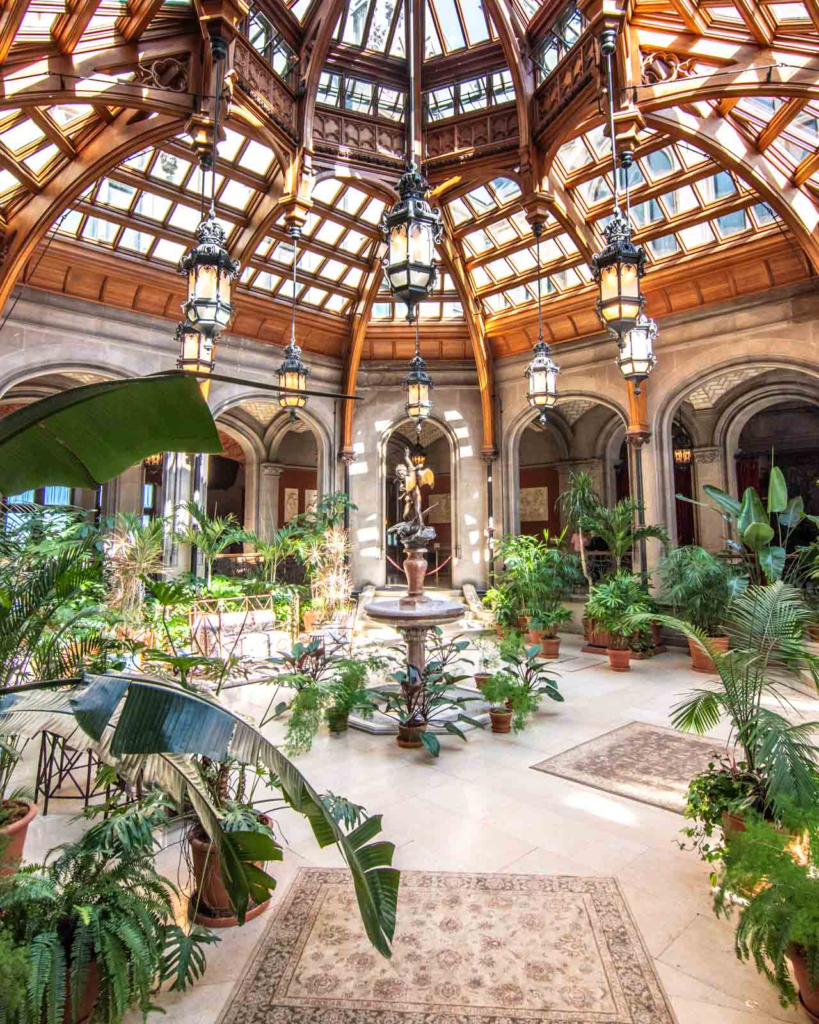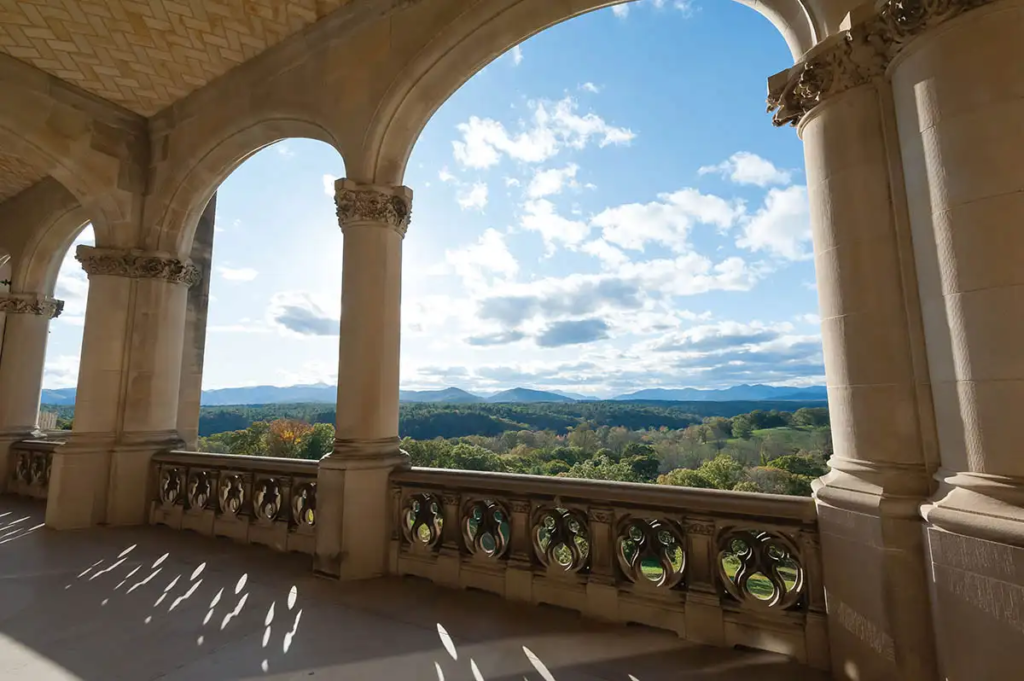The Gilded Age was a time of tremendous economic and political change within the United States, but its most visible legacy are the grand mansions built by the titans of industry. From the shores of Newport, Rhode Island to Long Island’s Gold Coast, wealthy industrialists built palatial estates that rivaled the palaces of Europe. But to find the largest of the Gilded Age mansions, you must journey to a somewhat unexpected portion of the country. There, nestled in the Blue Ridge Mountains of western North Carolina, stands the Biltmore Estate, the largest private home ever built in America.
Built for George Washington Vanderbilt III, grandson of Cornelius Vanderbilt, the Biltmore Estate is a 250-room French Chateau covering more than 175,000 square feet. Vanderbilt first visited Asheville in 1888, and instantly fell in love with the area. It wasn’t long before he decided to build a home here, purchasing 125,000 acres of land in the heart of the Blue Ridge Mountains. The foundation of what would ultimately become America’s grandest country estate, and one of my favorite places to visit.

In hindsight, I suppose the Biltmore was destined to become a great estate. Not only was it to be situated on 125,000 acres of pristine land, but Vanderbilt hired a dream team to design the estate. For the home, Vanderbilt commissioned Richard Morris Hunt, the most successful and sought-after American architect of the 19th century. Perhaps more importantly though, was Vanderbilt’s choice of landscape architect to design the grounds. For that task he retained Frederick Law Olmsted, the celebrated designer of New York’s Central Park.
In a way the Biltmore Estate serves as a monument to both of these men, as it was the final project of both these great artists. George Vanderbilt recognized the contributions of both artists, even before the construction of Biltmore was complete. In a rather unusual move, he commissioned renowned portrait painter John Singer Sargent to commemorate Biltmore’s architect and landscape architect. Their portraits still hang on the walls of the Biltmore Mansion to this day.

Whether touring the interior of the Biltmore or enjoying the estate’s perfectly manicured gardens, it’s impossible not to appreciate the estate’s beauty. Walking through the halls of the Biltmore, your mind naturally wanders. What would it have been like to live here? I can only imagine the elegant parties, which undoubtedly featured plenty of distinguished guests. The mansion’s living space covers more than 175,000 square feet, and includes 35 bedrooms, 43 bathrooms, and 65 fireplaces. If there was ever a home designed for entertaining on a grand scale, Biltmore is it.
The number of fireplaces always strikes me as being particularly impressive, as well as reminds me of one of the more interesting fun facts about the estate. Architect Richard Morris Hunt designed the Biltmore Mansion to be fireproof. Not only were fireproof materials utilized, but the mansion was designed in sections that could be isolated in the event of a fire, much like the compartments on a ship. This unique design feature and Biltmore’s remote location, made it a perfect hiding place for valuable treasures.

During World War II, the National Gallery of Art decided to utilize Biltmore as a hiding place for numerous works of art, many of them priceless. Just weeks after the attack on Pearl Harbor, the treasures were loaded on a train, and shipped from Washington to Asheville. For several years, Biltmore’s Music Room housed 62 paintings and 17 sculptures, some of the world’s great cultural treasures. Among the collection were paintings by artists such as Raphael, Vermeer, Rembrandt, and Goya. Also among the treasures hidden at Biltmore, was the Athenaeum Portrait, the famous portrait of George Washington, which was used as the model for Washington’s depiction on the one-dollar bill.

While the Biltmore is certainly grand, it also feels surprisingly homey. Unlike other Gilded Age mansions, Biltmore feels like a place where real people lived their lives. The furnishings aren’t overly opulent, and you get the sense that’s very much by design. There are certainly sections of the mansion that are over the top, such as the Banquet Hall, but others feel surprisingly normal. One of my favorite parts of the house is the veranda, not so much for its design, but rather for the view. To stand there and think that all the land to the horizon was once part of the estate, it really puts into perspective the immense size of the estate.

The mansion itself is so remarkable that you might think a tour of the estate’s grounds would pale in comparison, but they most certainly hold their own. Featuring both formal and natural gardens, the grounds of the estate are an assault on the senses. The Biltmore Estate currently encompasses 8,000 acres, a fraction of its original 125,000 acres. Much of the original land was sold to the Forest Service, and became Pisgah National Forest. The transition to a National Forest seems most appropriate, as Biltmore is the birthplace of American Forestry.
“My advice would be to make a small park in which you look from your house, make a small pleasure ground and gardens….and make the rest a forest.”
Frederick Law Olmsted

While today the Biltmore Mansion is surrounded by thousands of acres of lush forests, this isn’t what the land looked like when George Vanderbilt purchased it. Much of the land constituted overworked farmland, but Vanderbilt had a vision for what it might become. He hired Gifford Pinchot, who later served as the first chief of the United States Forest Service, to develop a forest management plan. Pinchot’s scientific forestry plan was an innovation in the United States and served as a national model. The fruits of that effort are still on display, the vast expanses of lush forests extending to the horizon, which serve as an idyllic background for the mansion.

The Biltmore Estate is one of my favorite places to visit, and I can’t recommend it highly enough. The only real criticism I can levy is that ticket prices are a bit steep relative to other Gilded Age mansions, with tickets starting around $70. But I suppose that’s to be expected, maintaining an estate of this size is incredibly expensive, and I’m more than happy to contribute to such efforts. If you have even the slightest interest in historic homes, the price of admission is well worth it. Also given the size of the estate, and how much there is to do outside, you could easily spend all day at the Biltmore.

